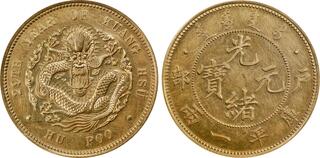| Stack's Bowers Galleries (& Ponterio) > April 2024 Hong Kong Auction | Auction date: 15 April 2024 |
| Lot number: 40118 Price realized: 27,000 USD (Approx. 25,407 EUR) Note: Prices do not include buyer's fees. | Show similar lots on CoinArchives Find similar lots in upcoming auctions on |
| Lot description: (t) CHINA. Gold K'uping Tael Pattern Restrike, "Year 29 (1903)" (ca. 1970s). Uncertain Mint in Switzerland (struck from Osaka Mint dies). Kuang-hsu (Guangxu). NGC PROOF-62. L&M-1019; Fr-Unlisted; K-927; KM-Pn296; WS-0001; Wenchao-6 (rarity: ★★★★★). Although a modern restrike struck from original dies, this issue remains EXCEPTIONALLY RARE and highly sought after by collectors given its elegant and wondrous design. This type seldom appears on the market and can often be considered virtually uncollectable. Extremely vibrant and radiant, with a majestic degree of mirrored brilliance in the fields and expertly struck devices. Some subtle cabinet friction accounts for the overall designation, but is easily overlooked on account of its superlative and extraordinary nature. Although officially struck off-metal in silver and seemingly bronze at the Tientsin Mint, the original dies were ordered from and prepared by the Osaka Mint in Japan, with any version and generation considered EXTREMELY RARE and desirable. The order for this new series of denominations and coining system was done under the supervision of Robert Hart, Inspector General of Maritime Customs. The initial goal was an early attempt to unify Chinese coinage under the gold standard. Denominations were produced in 1 Tael as well as 5, 2, 1 and 1/2 Mace (5 Candareens). The project failed for several reasons and never came to fruition, with one of the major forms of resistance coming from the directors of the provincial mints, as the plan called for one central mint being responsible for coinage production. This was meant to ensure the uniformity of the new coinage, and would have cut into the profits of the provincial directors. Also, at this time, there was no plan in place to deal with the vastly different types of paper money circulating in China, nor was there a plan regarding acceptance and exchange of these disparate currencies. It would appear that the gold versions of these denominations, including the Tael presented here, were struck with the original dies at a later date in the 1970s, with a mint in Switzerland issuing sets of the denominations in their intended gold format. Allegedly, the dies were used again in the 1980s for subsequent gold restrikes, with said dies receiving some "re-touching." Of note, one can see some subtle evidence of die rust on the present example, such as below and to the left of the P in "POO" on the dragon side, and below the "hu" character (戸) on the characters side. As such, it would appear that the present example would, at the very least, emanate from an "initial" restriking using the dies, as characteristics like the aforementioned die rust would seemingly have been removed at some point later on. Of further intrigue, one can detect similar instances of die rust and/or cracks on the silver counterparts, leading to the conclusion that some of the silver strikings with these dies may also, in fact, be later issues rather than contemporary to 1903. Estimate: $30000 - $50000 |  |



